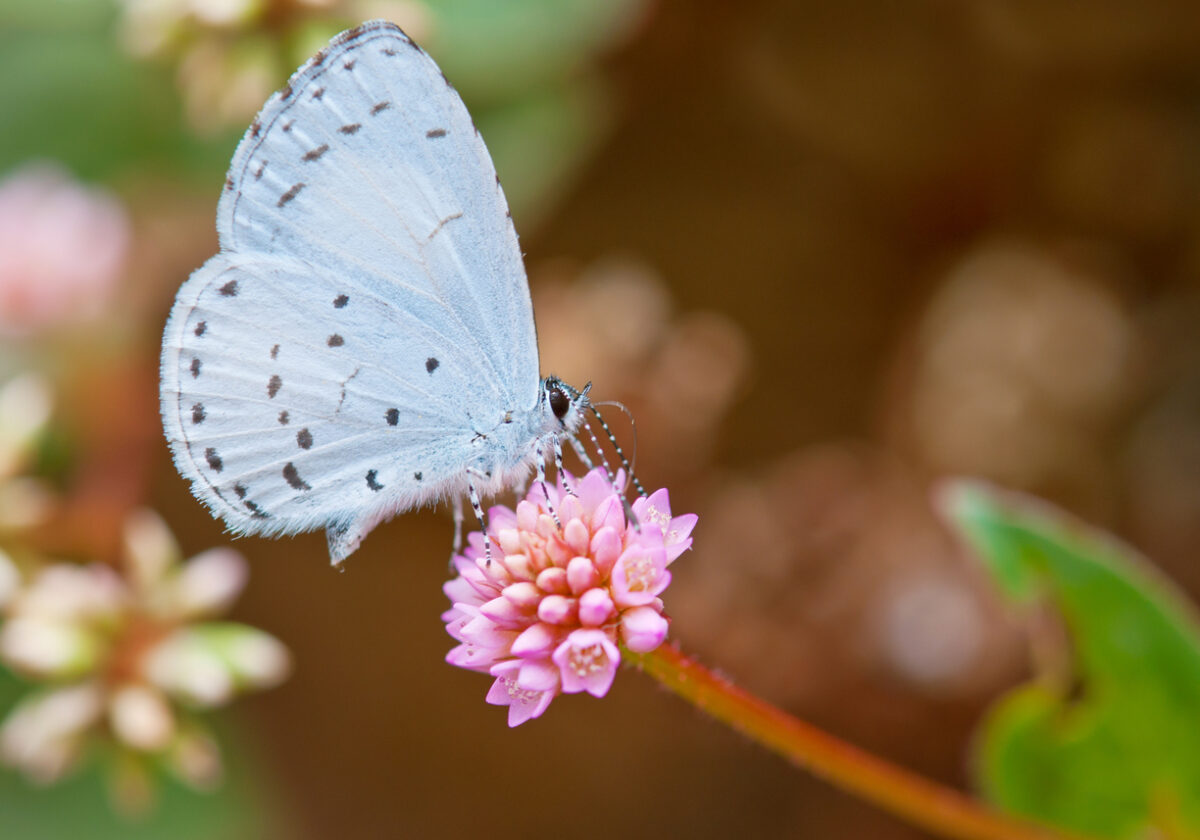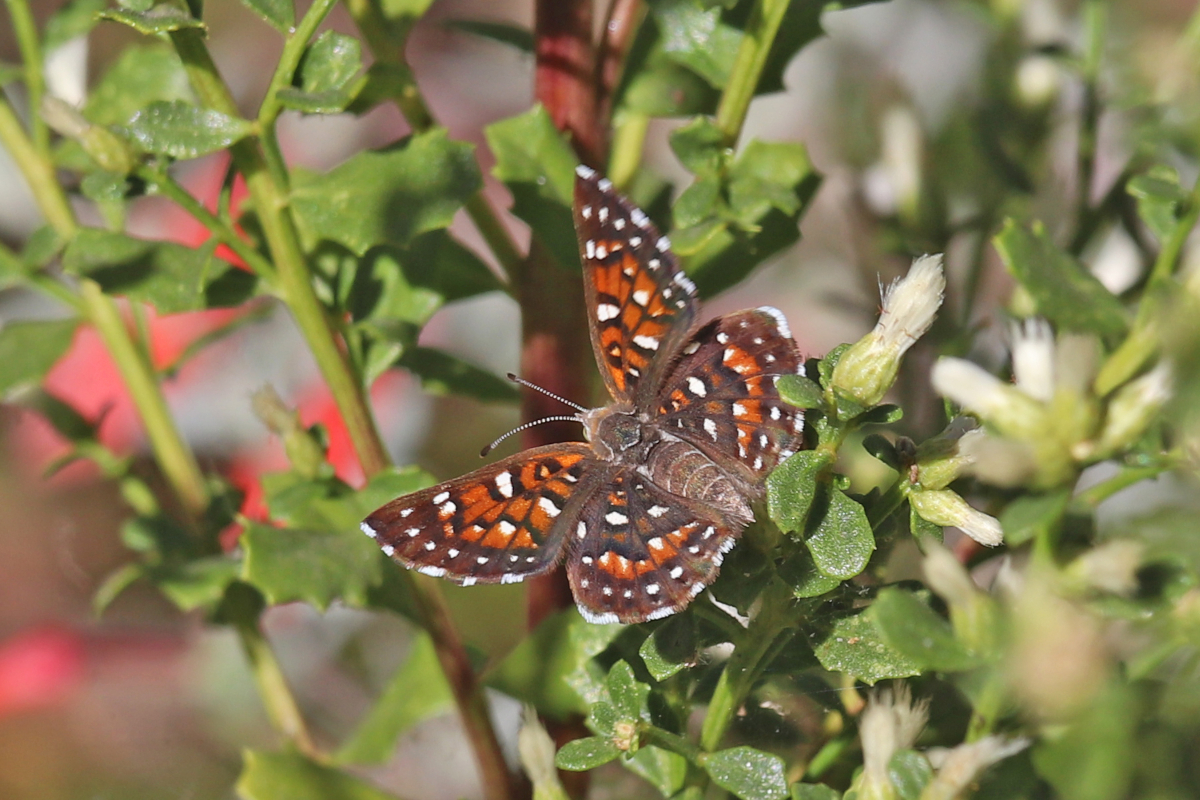

We may earn revenue from the products available on this page and participate in affiliate programs. Learn More ›
Butterflies signal summer, often reminding us of carefree childhood days. They’re beautiful and perhaps a bit mystical, floating on air, flitting from flower to flower seemingly without a plan. They’re also a cultural metaphor for hope, change, and transformation—a symbol of rebirth or resurrection.
Of course, butterflies also have an important job, along with moths, bees, birds, and bats, as pollinators. All told, these creatures pollinate more than 75 percent of all flowering plants worldwide.
While many people recognize the iconic monarch butterfly, not everyone can identify other types of butterflies. Get to know the characteristics associated with these common butterfly names and enjoy attracting butterflies to your garden.
RELATED: 3 Container Garden Combos for Attracting Pollinators
1. Monarch Butterfly

Known for its 3,000-mile annual migration and striking orange-and-black wings, the monarch butterfly is now endangered due to habitat loss caused by urbanization, monocrop agriculture, and pesticide use. Monarch caterpillars feed exclusively on milkweed and lay their eggs on the undersides of its leaves; the toxins from this plant make them unattractive to predators.
Key Characteristics: Distinguished by brilliant orange wings with black edges and white dots, monarchs have a large 4-inch wingspan, and they can be counted among the most beloved butterflies in the U.S. Monarch caterpillars are also large, with vibrant stripes of black, white, and yellow.
Habitat Range: Found throughout the U.S. and southern Canada, most monarchs migrate every year to Central Mexico, where they winter; a smaller number of Western monarchs spend winter along the California coast.
2. Mourning Cloak Butterfly

One of the longest-lived butterflies, the mourning cloak features almost ragged-looking wings, with irregular, rough edges. Their wings are purplish-black with a wide yellow border and iridescent blue dots just inside the border. The caterpillars feast on trees such as willows, elms, and birch, while the adults prefer tree sap from oaks.
Key Characteristics: The bright yellow border and iridescent blue spots on dark wings help the mourning cloak butterfly stand out.
Habitat Range: Mourning cloak butterflies can be found throughout the U.S. and as far south as Central Mexico, although they are rarer along the Gulf Coast and Florida.
3. Painted Lady Butterfly

The orange-and-black wings of the painted lady exhibit a multitude of spots, including two “eyespots” on the hind wing. They feed on nectar from thistles, red clover, hollyhocks, and more. These butterflies’ host plants include thistle, hollyhock, and mallow. As one of the most common species in the world, gardeners view painted ladies frequently.
Key Characteristics: About 2 to 2.5 inches wide, the painted lady is a colorful butterfly. Sometimes confused for the American lady, the painted lady has only two “eyespots,” as opposed to the American lady’s four.
Habitat Range: Painted lady butterflies can be found throughout the U.S., Mexico, and most of Canada. Because they don’t go dormant in the winter, they can be seen in warmer climates year-round.
RELATED: Don’t Kill These 17 Beneficial Insects in Your Garden
4. Black Swallowtail Butterfly

Blue scaling separates rows of yellow spots on the black wings of the black swallowtail. Males have larger yellow spots, while females have more blue scales on their lower wings. Both like nectar from clover, thistles, and milkweed. Some of their favorite host plants include herbs and vegetables like dill, fennel, carrots, celery, and parsley. They are commonly seen in open fields, farms, and urban areas.
Key Characteristics: A border of yellow spots along the edges of black wings denotes the black swallowtail, which can measure anywhere from 2.5 to 4 inches wide.
Habitat Range: The black swallowtail can be found all across the U.S., from southern Canada to the Gulf of Mexico.
5. Two-Tailed Swallowtail Butterfly

Two-tailed swallowtails are a larger butterfly variety, and they exhibit yellow wings with black borders and narrow tiger stripes on their forewings. Their hindwings have two tails, with iridescent blue and orange spots. Host plants include ash trees and chokecherries, while nectar comes from milkweed, thistles, and other plants. They can be seen in foothill slopes, canyons, valleys, stream sides, woodlands, parks, roadsides, cities, and suburbs.
Key Characteristics: Their sharply angled yellow wings are offset by black bordering and narrow tiger stripes, but it may be the elaborate double tail with iridescent blue spots that makes these swallowtails stand out the most.
Habitat Range: The two-tailed swallowtail is found predominantly along the West Coast, from British Columbia to Mexico, and as far east as central Nebraska and Texas.
6. Zebra Swallowtail Butterfly

Tennessee’s state butterfly, the zebra swallowtail is identified by its long, triangular white wings with black zebra-like stripes. These butterflies have two blue spots and long, thin tails at the ends of their wings, with red spots on the wings near the lower part of the body and a reddish antenna. Approximately 2 to 4 inches wide, adults like nectar from redbud trees, milkweed, and verbena, while caterpillars feed on paw paw leaves.
Key Characteristics: The striking black-and-white “stripes” reminiscent of a zebra pattern adorn this swallowtail, with its long tails and red highlights.
Habitat Range: Zebra swallowtail butterflies are primarily found along moist, low woodlands near rivers and swamps in the southern portion of the Chesapeake Bay watershed, including Delaware, Maryland, Virginia, and West Virginia.
RELATED: 10 Ways to Make Your Garden More Bee-Friendly
7. Spring Azure Butterfly

This small blue butterfly has one of the shortest lifespans of all butterflies. Male spring azure butterflies are bright blue; females are darker blue, with black bands around the edges of their wings. They like nectar from blackberry, dogbane, privet, New Jersey tea, and milkweed, while relying on host plants such as dogwood and New Jersey tea.
Key Characteristics: Spring azures are about 1-inch in size and almost solid blue in color—including their bodies.
Habitat Range: Spring azures can be found in fields, clearings, along the edges of deciduous woods, freshwater swamps, and wooded marshes from Alaska and Canada to the Columbia Mountains, as well as throughout much of the U.S.
8. Gray Hairstreak Butterfly

With an average wingspan of just over 1 inch, the small gray hairstreak butterfly has blue-gray wings with one or two thin hair-like tails on the lower corner of each hindwing. They have large reddish-orange eyespots near the base of each tail, as well as an orange spot at the back of their head. The males have an orange abdomen. Host plants for caterpillars include mallow, beans, clover, peas, and cotton (and for this, they’re also known as cotton square borers). Adult gray hairstreaks feast on nectar from a wide variety of plants, including milkweed, white clover, goldenrod, and mint.
Key Characteristics: The small gray hairstreak features blue-gray wings with thin hair-like tails on the corner of their hindwings.
Habitat Range: Widely scattered through the U.S., Canada, Central America, and the northern part of South America, gray hairstreak butterflies like open, non-forested areas and weedy places.
9. American Copper Butterfly

This medium-sized butterfly displays bright orange-red upper wings with black spots, edged in gray. Their hindwing is gray with matching orange-red border along the edge. Host plants for American copper caterpillars include sheep sorrel and curled dock, while adults take nectar from common buttercup, white clover, butterfly weed, yarrow, ox-eye daisy, and other native flowers.
Key Characteristics: The fiery red-orange of their upper wings, color-coordinated with the same color border on their lower, gray wings, distinguishes the American copper.
Habitat Range: American copper butterflies prefer pastures, landfills, old fields, the edges of roads, and other disturbed places in the Northeast and Upper Midwest from Nova Scotia to Georgia and Tennessee, and as far west as North Dakota.
RELATED: 23 Types of Hummingbirds All Backyard Birdwatchers Should Know
10. Cabbage White Butterfly

Accidentally introduced to North America from Asia, Europe, and Africa, this invasive insect is unpopular with farmers and gardeners because its caterpillars eat cabbage, kale, broccoli, radishes, and horseradish. Adult cabbage white butterflies seek nectar from a variety of flowers. A medium-sized butterfly, males are creamy white with a single black spot on their primary wings, while females are pale yellow with two black spots near their wings’ center.
Key Characteristics: Sometimes mistaken for moths, cabbage white butterflies are just under 2 inches wide and feature either creamy white or pale yellow wings, depending on gender.
Habitat Range: Originally native to Asia, Europe, and Africa, cabbage whites are an invasive butterfly species in North America, Australia, and New Zealand.
11. Clouded Sulphur Butterfly

These little yellow butterflies are prevalent throughout North America. They measure up to 2 inches wide, and they’re easy to see thanks to their lemon-yellow wings—with solid black borders on males and yellow-spotted black borders on females. True to their name, clouded sulphur butterflies are also easy to smell, producing a sulfuric odor similar to rotten eggs. They love dandelions in particular, while taking nectar from 43 species of plants. The clouded sulphur caterpillar’s host plant is white clover.
Key Characteristics: The small yellow butterfly is common in the U.S., Canada, and Northern Mexico. It visits a wide variety of plants and emits a sulfur smell.
Habitat Range: Clouded sulphur butterflies are found from Alaska to Newfoundland and as far south as Mexico. They aren’t usually seen in Southern California coastal areas, along the Gulf Coast, or in much of Florida.
12. Orange Sulphur Butterfly

Most orange sulphur butterflies are orange and yellow, sporting a dark-brown or black border around their top wing’s edge. Females may be white or slightly greenish. Like other sulphur butterflies, they grow to about 2 inches. These have a fondness for alfalfa, leading them to be referred to as the alfalfa butterfly. They also like clover, milkweed, and sunflowers, and orange sulphur caterpillars use alfalfa and other pea family plants as hosts.
Key Characteristics: A medium-sized butterfly featuring orange-yellow wings with dark borders, the orange sulphur is prevalent throughout North America and Mexico.
Habitat Range: The orange sulphur can be seen in farm fields, pastures, meadows, and lawns from southern Canada to Central Mexico.
RELATED: Grow This, Not That: 12 Native Alternatives to Invasive Plants
13. Common Checkered Skipper Butterfly

Male common checkered skippers have blue-gray upper sides and partial black checks in their fringe, while females are black. Both have large white spots that form bands across both wings, alternating with darker bands. This species has larger bodies with bluish fuzz and smaller wings than other butterfly types. Mallow is the host plant for common checkered skipper caterpillars, and adults draw nectar from fleabane, asters, red clover, and knapweed, among other plants.
Key Characteristics: This medium-sized butterfly has muted tones, attractive bands of white, and dark check mark shapes across their wings.
Habitat Range: Common checkered skippers prefer sunny, open areas with low plant growth and even bare soil. They’re found in prairies, meadows, fields, roadsides, yards, gardens, and pastures in temperate areas of North America, from Southern California across the Gulf Coast and all the way down to the mountains of Northern Mexico.
14. Delaware Skipper Butterfly

Like the common checkered skipper, the Delaware skipper has a larger body and smaller wings associated with the skipper butterfly family. Its wings are a bright yellow-orange with dark-brown veins and black borders. The undersides lack markings but may display orange veins, and female Delaware skippers have wider borders and darker markings. Host plants include switchgrass, wooly beard grass, and other grasses. Adults get nectar from a variety of pink and white flowers, including milkweed, mountain mint, marsh fleabane, buttonbush, thistle, and pickerel.
Key Characteristics: Delaware skippers have yellow-orange wings with dark-brown veins, bordered in black.
Habitat Range: Delaware Skippers like moist areas such as marshes, and prairies, fields, roadsides and yards. They live primarily in the Northeast, from southern Maine and southern Canada to central Montana, and as far south as Florida, the Gulf states, New Mexico, and El Salvador.
15. Common Sootywing Butterfly

Sootywings are large, dark butterflies with thick bodies. Their upper sides are black or a very dark brown and feature white spots on the outer third of the forewing. Meanwhile, their hindwings are completely dark. Common sootywings owe their name to the slightly frayed-looking lighter brown edges of their wings, which look like iron filings or soot deposits. They get nectar from a variety of plants, including dogbane, marjoram, oxalis, white clover, milkweed, peppermint, cucumbers, and melons.
Key Characteristics: This large, dark butterfly features light brown “rust” fringes on the edges of their wings and white spots on their forewings.
Habitat Range: The common sootywing butterfly is found in gardens, fields, roadsides, and other disturbed areas in central parts of the U.S., peninsular Florida, and Central Mexico.
RELATED: 7 7 Brilliant Ways to Attract Fireflies to Your Yard
16. Mormon Metalmark Butterfly

A small butterfly only around a half-inch wide, the Mormon metalmark butterfly has short, broad wings that can be red-orange, brown, or black with distinctive black and white spots. Its fringes are white with black checks, the forewings feature a red patch, and the hindwings have no orange coloring. Mormon metalmarks fly low to the ground in bright sunshine. Wild buckwheat is the host plant for its caterpillars, while adults extract nectar from various plants, such as clematis, rabbitbrush, and California aster.
Key Characteristics: Large white spots edged in black and orange “shoulders” on brown wings mark the Mormon metalmark butterfly.
Habitat Range: Mormon metalmarks like sunny open spaces, dunes, and rocky areas in the Western U.S., reaching from British Columbia and Saskatchewan down to New Mexico, Baja California, and Mexico.
17. Palmer’s Metalmark Butterfly

Also known as gray metalmark, Palmer’s metalmark features gray or dark-brown wings with a copper tinge. Black-edged white spots cover the wings and can form bands along their margins. Undersides are orange with white spots and black submarginal spots. These butterflies get nectar from a variety of flowers, but daisies and thistle are two of their favorites.
Key Characteristics: This medium-sized butterfly has gray or brown wings highlighted by numerous white and black spots.
Habitat Range: Palmer’s metalmarks like the thorn scrub and mesquite deserts common in the U.S. Southwest, namely West Texas, New Mexico, Arizona, and southern portions of Nevada, Utah, and California. They can also be found in Baja California and Central Mexico.
18. Fatal Metalmark Butterfly

Fatal metalmarks are slightly smaller at a width of 1 inch, and they have more subtle coloring than other metalmark butterflies. Their upper sides are chocolate brown with slightly darker, irregular median bands crossing their wings and checkered fringes. Clematis and seep willow are host plants for caterpillars, while adults get nectar from California brittlebush and clematis, among other plants.
Key Characteristics: A small butterfly, the fatal metalmark features brown coloring with subtle darker brown bands.
Habitat Range: They can be found in brush and weedy roadsides, washes, ditches, chaparral canyons, and other arid areas stretching from Southern California to Central Texas, all the way down to Southern Mexico.
